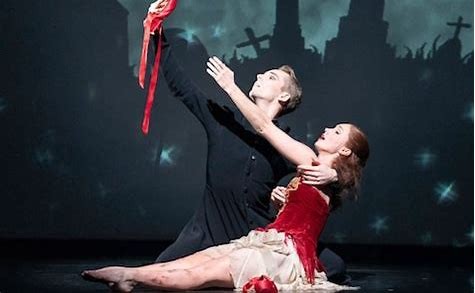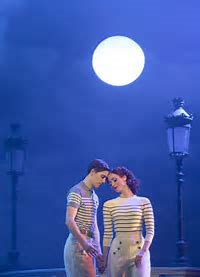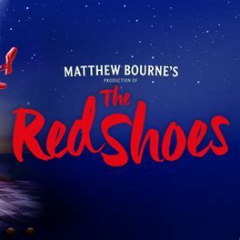The event
On the 29th of January 2020 I went to Milton Keynes to see Matthew Bourne’s production of The Red Shoes at Milton Keynes Theatre. The performance was predominantly a ballet, however there were some contemporary elements in certain scenes to add contrast, emotion and dynamics. The Red Shoes is choreographed and directed by Matthew Bourne with brilliant music by Bernard Hermann and orchestration by Terry Davies.
Before watching this production, I had seen one ballet before – the Nutcracker – however I watched it a long time ago and I do not remember it well. In addition to this I have also seen many musicals, for example Matilda, The Lion King and Wicked at the West End as well as plays such as Twelfth Night at The Globe Theatre. Personally, I think that I prefer musicals to ballets because they have memorable songs and the plot is easier to follow as there is a script. However, they are both very different ways of story telling and so are hard to compare. The Red Shoes taught me that you do not need words to tell a story and also gave me tons of inspiration for choreography for my own dances.
The story
Act One starts with an upper-class party. At the party Nadia performs a solo to entertain the guests, where she is spotted by a famous choreographer/ director called Boris Lermontov. Nadia goes to work with Lermontov and during her first week of working with him the lead dancer in the ballet that the company (The Red Shoes) is working on gets an injury and Nadia is asked to step in as the lead. The company tours and has a brilliant time performing their own production of The Red Shoes (a ballet about a young girl who puts on red shoes and cannot stop dancing, which results in her death). During this Nadia starts to fall in love with the composer for the company, Julian. Act One finishes.
Act Two starts a while later and Nadia and Julian are a couple. Lermontov confronts Julian for composing ‘old’ music and fires him. Nadia decides to quit the company to stay with Julian. Nadia and Julian start performing in music hall theatre. Eventually, Nadia realises that she cannot live without dance and leaves Julian to return to Lermontov’s company. She continues touring in the companies ballet with her lead role. Much like her character in the production of the Red Shoes, Nadia cannot stop dancing - so much so that it controls her actions and she somehow ends up on a railway line and is hit by a train. It is unclear whether her death is suicide or accident. Julian comes back from his travels to find her dying and takes off the red shoes, hoping it will free her. Sadly, it does not.
What I liked
Costumes: during most of the performance each scene had its own set of complementary colours that represented the characters and mood in the room. For example, in the opening scene, at the beginning each dancer wore a slightly different single-coloured outfit that was either yellow, orange, gold or beige to represent how all the characters were rich and happy but in a calm manner. In addition, during the funeral scene all the dancers wore either dark grey or black to highlight the gloomy and sad mood on the scene. The only exception to this rule would be a beach scene when the dancers did not wear a single colour but instead wore bright, contrasting block colours to show their happiness in a more fun way.
When an important character needed to be shown clearly, they would wear a costume that slightly goes against the colour scheme to make them stand out and seem different to the others. For example, when Nadia was performing in front of the rich people during the party she wore a gorgeous bright emerald dress that stood out against the dull beige colours of the other dancers, this made sure that the audience knew where to look as well as perfectly representing how she did not belong with the rich people. This technique was also used at the beginning when Nadia stepped through the curtain wearing the emerald dress and the red shoes and this contrast made the audience immediately notice these special shoes.
During the music hall scene the costumes were used to emphasise how (other than Nadia) no one was taking dance very seriously. The outfits showed this by having silly costumes that did not look professional or put together at all.
Other than the emerald dress, the red shoes character’s costume was one of my favourites. I loved this costume because it perfectly depicted the character’s sinister and evil personality without using anything too cliched like a cape or horns. The shoes were represented by a man in a pinstripe suit of black and red holding the shoes in his hand as though they were extension of his arm. His hair was slicked back to put further emphasis on his villainous attributes.
In some scenes dancers wore black floaty dresses that caused them to look unmistakably like shadows dancing around. This really helped to build the murky atmosphere of these scenes.
I particularly liked how all the costumes mimicked the fashions of when the ballet was set – 1948. All the costumes are based off popular fashions from the late 40s and some from the early 50s. Throughout the performance I noticed many adaptions of Christian Dior’s haute couture collection The New Look 1947. (You can see this design at the Dior exhibition, like I did last year). Most outfits for the ballerinas included a fitted jacket over a long floaty pleated skirt. This was a popular outfit choice for ladies during this time.
Characterisation/choreography: all the choreography beautifully showed the story without using any script. I was surprised that I basically always knew what was going on even though the story was only told through the medium of dance.
One of my favourite parts of all the ballet was all the creative lifts. During the scene at the beach there were many hilarious lifts that were made to look like people swimming. I particularly loved the scene when Matthew Bourne choreographed the dancers to represent the wind. This was shown in a series of floaty lifts that kept changing direction. The people being lifted were carried all over the stage and never once put their feet on the ground and they made it look very effortless. I loved this scene because it was so beautifully choreographed, and I know that I will remember it for a long time.
One of the solos that I really liked was when Julian was thinking of new ideas for a composition. This solo clearly showed how frustrated he was by showing him dance side to side, similar to how people pace back and forth when they are thinking. This dance also used the set very well with lots of movements involving either jumping across the piano or dancing on it. I really liked how the dance style was slightly different (more acrobatic) to the other dances to show how different he is to the other characters.
Another solo I really liked was when the character of the red shoes was tempting Nadia. This dance included a lot of low fast movements with occasional slow ones to change the dynamics and keep the audience on their toes. This made him look more villainous because the low movements created the idea that he was creeping around, something that is commonly associated with evil.
At the beginning of Act Two Julian and Nadia share a dance. This dance clearly shows the audience that they are now together because there is constant close contact and many lifts that emphasise their trust in each other. Another dance that they have together later in Act Two also shows the two dancing closely together. However, they are not completely touching and this showed that they are having a rough time in their relationship. Another dance that I really liked was also at the beginning of Act Two. This scene included many different styles of dance, for example the Cha Cha, the jive and even the conga. The different styles were used to represent a contrast in how serious and hard-working the characters normally are to how happy they were in that scene.
Props and lighting: during most of the ballet the main prop was the magnificent proscenium arch on wheels. One side of the arch was gold and the other side changed dependent upon the scene. For example, at the ballroom the gold side would be facing the front but during the red shoes’ solo the red side of the arch faced the front.
Sometimes the arch would move to divide the stage into two halves, this was used during a split scene in Act One. A final way that the arch was used was to show the audience times and places. A date and the name of a city would be projected onto the curtain to help move the story along.
Props were also used to create contrast in the performance. For example, in Act One clean white walls bordered the edges of the stage and looked very modern compared to the late 1940s aesthetic.
Other aspects I like: I really liked how sudden the beginning was. Unlike usual performances where the light slowly dim and the music come son in a crescendo, in this performance the lights suddenly switched off and almost immediately after that a single spotlight hit the stage. This was good as it really set the tone for the dramatic ballet that followed it.
Other aspects I liked: Although it was a ballet the acting was amazing! There was a scene where one of the dancers had to pretend to be almost perfect. This seemed really hard to do as she had to dance a little worse than she was but the dancer pulled it off.
Even thought the Red Shoes is a serious ballet, Matthew Bourne managed to add humour. This included small parts, like when the lead dancer tripped and really over dramatized her accident, constantly gasping and fainting, as well as larger parts like the random Egyptian dance in the music hall.
What I did not like:
Overall, I liked the majority of the event, however some parts did stick out to me as not being as good as the rest of the performance. One of my main critiques was the lack of a live band. Although the music was very good I personally would have preferred live music as this would have added to the overall atmosphere of the performance as well as the overall package of going to the ballet. I also think that the ending was too abrupt. Although this might have been done for impact and drama, I think that the performance should have explored the main character becoming addicted to dance more, as well as her love story.
The train at the end did not seem as realistic as the other props. It looked more like cardboard than metal but I don’t really mind since I realise that it is very hard (and expensive) to make a replica of the front of a train. Finally, I got very confused when they started the ballet within the ballet. When it finished I genuinely thought that the actual performance had finished (I even started clapping) until the proscenium arch located to reveal backstage where the dancers were still performing. However, I was the only person in the audience clapping and so it might just have been me that got confused.
My final thoughts.
Overall, this performance of The Red Shoes completely exceeded my expectations. I would definitely recommend it to anyone above the age of 12. This is because of some mature themes and they might get bored of the constant dance with no script/acting. It is also quite a long production, however I am quite sure some kids 12 or under could still love this ballet without fully understanding it. This ballet can be enjoyed in groups or alone. I absolutely loved this performance and would give it a 9.98 out of 10! I believe that I will remember this dance for a long time and would love to watch it again when I am older to see if any of the meaning would be different or stay the same.
Thank you for reading my review of Matthew Bourne’s The Red Shoes and I hope you watch it and love it as much as I do.









This is a great review Lara - you have been very thorough and shown what the highlights were and also parts that you felt were not as effective. I agree with you that live music is always preferable! Have you seen any other Matthew Bourne productions?